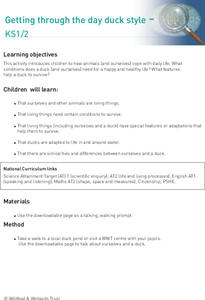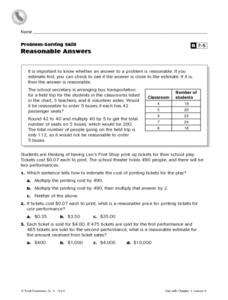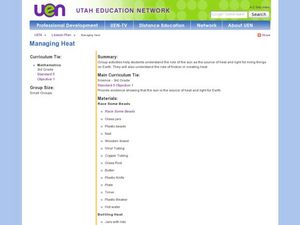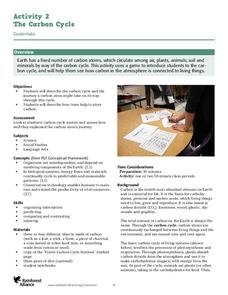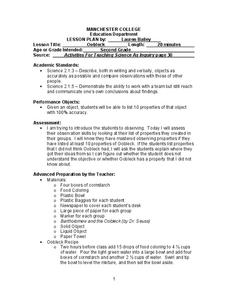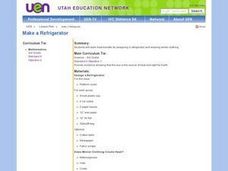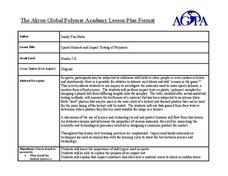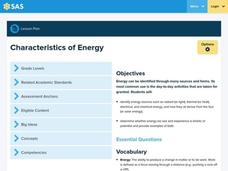Curated OER
Incredible Iceboats
Students explore the concept of floating objects (ice). In this floating lesson, students conduct an investigation in which they hypothesize about the time that an ice boat will last floating in water. Students record their...
Curated OER
Some of Its Parts
Learners study a can opener to find the important parts that make it possible to take the lid off a can of food. They then use this information to decide what new or different subsystems could be added to make it better and explain how...
Curated OER
Milkweed Plants
Second graders view milkweed plants (or pictures). The describe the plant and discuss ways some butterflies use it as a food source. Students view four pictures of different phases of a milkweed plant's life cycle. They discuss the...
Curated OER
Shake, Rattle and Roll
Students compare the weathering of materials. in this weathering instructional activity, students experiment with the chemical and physical weathering of different materials. Students use salt and water as an example of how weathering...
Curated OER
By Golly By Gum
Young scholars identify the different steps in the scientific method. In this inquiry lesson, students determine the mass of the gum after chewing it for sometime. They explain what happens to the lost mass.
Curated OER
Liquids of Different Densities
Students compare the densities of different liquids. In this liquids lesson plan, students compare color, viscosity, weight, volume, and graph their findings.
Curated OER
Observing the Growth Spurt
Learners notice a growth spurt in their Brassica plants and closely monitor this growth by measuring their plants and predicting the next day's growth based on the pattern of their data. They also read and highlight the objectives in...
Curated OER
Cornbread Addition
Fourth graders, after being given a box of cornbread mix, follow the directions to make the cornbread. They utilize measuring cups to mix all the ingredients together and incorporate adding simple fractions while mixing up the cornbread.
Curated OER
Light My Fire
Students determine the number of calories in various products, and the amount of energy created when objects burn.
Cornell University
Buoyancy
Swimmers know to float by turning their bodies horizontally rather than vertically, but why does that make a difference? In an interesting instructional activity, scholars explore buoyancy and the properties of air and water. They test...
Curated OER
Getting Through the Day Duck Style
Students observe ducks at a local wetland. They answer various questions about the ducks behavior and write the answers on a downloadable worksheet.
Curated OER
Problem Solving Skill: Reasonable Answers
In this problem solving worksheet, students read a story problem on the cost of fabric and then answer 4 fill in the blank problems regarding the price of fabric and whether or not it is reasonable.
Curated OER
Managing Heat
Third graders perform various experiments to show the flow of energy that causes heat. In this heat lesson, 3rd graders understand how heat is transferred or trapped. Students use the scientific method and critical thinking skills to...
Curated OER
Toting the Log and Lifting the Babe
Students use simple machines that demonstrate force, friction, work and power. They investigate and explain simple machines.
It's About Time
Polymers
All plastics contain polymers, but not all polymers are plastic. Young chemists make their own polymer and compare the properties to those of other states of matter. After a reading passage, pupils answer analysis questions about natural...
Rainforest Alliance
The Carbon Cycle
Scholars learn about the carbon cycle, play a carbon cycle game, and then write a story based on their role as a carbon atom during the game. After the writings, pupils analyze the carbon cycle by leading a class discussion on the material.
Curated OER
Oobleck
Second graders observe the properties of Oobleck. In this science and observation lesson, 2nd graders examine Oobleck and make a list of 10 properties that they notice. They explain their observations.
Project Food, Land & People
Loco for Cocoa
Students create a time line and map about how chocolate traveled the world. In this chocolate lesson plan, students also create and taste chocolate.
Curated OER
Make a Refrigerator
Third graders explore the concept of heat transfer as experienced in wearing winter clothing and analyzing the refrigerator.
Curated OER
Sports Helmets and Impact Testing of Polymers
Learners examine the importance of good quality safety gear. In this investigative lesson, students will tests various polymers, collect data, and analyze the data to determine which polymer is best for safety helmets. They will design a...
Curated OER
Salinity Lab
For this salinity worksheet, students simulate conditions of salt and fresh water mixing and observe the various densities of these solutions based on their salinity.
Curated OER
World of Plastics and Polymers
Students investigate plastics and learn they are giant molecules made of carbon atoms. In this polymers and plastics lesson, students perform 3 activities which all include making polymers from household items such as milk and vinegar,...
Curated OER
Quilt Squared
Students study West Virginia quilts. In this mathematics instructional activity, students use symmetry, geometric shapes, and patterns to create their own quilt square.
Curated OER
Characteristics of Energy
Fourth graders view a video and create a KWL to identify energy sources. In this energy sources lesson, 4th graders explore the meaning of energy, kinetic energy, potential energy, thermal energy, radiant energy, and electrical energy....












